Table of Contents
The Concept of Triple Bottom Lines – Review
The Seven Drivers of Elkington
Relationship of TBL with Sustainable Development (SD)
Key Themes of Sustainable Development
Concerns for future generation
The need to improve quality of life for all.
The need for equity between different groups of people on earth
The need to balance between competing goals (economic, environmental, social).
The realization of the interdependency within and between all communities on earth.
Key Questions in Sustainable Development
Significance of TBL in Sustainable Development
Integrated Planning and Management
Significance of TBL in Sustainable Construction
Sustainable Construction Definitions
Objectives of Sustainable Construction
TBL Reporting Exercise based on Global Reporting Initiatives
Introduction of the Organization
Challenges and Issues in Reporting Sustainability
List of Tables and Figures
Table 1 The Seven Transitional areas (inspired by Elkington, 2004, 3)
Table 2 Summary of Key Areas, Goals, Risks
Figure 1 The Three Spheres of Sustainability
Figure 2 illustrations of TBL, Inspired by Elkington, 1994
Figure 3 Corporate Responsibility Landscape (McElhaney, 2008, 230)
Figure 4 Sustainable Development and TBL (Both Address the Same Aspect)
The sustainability related ides of TBL (Triple Bottom Line) was coined by Elkington (1997), according to which true sustainability relies on economic prosperity, social uplift environmental sustainability as a whole. Big organizations are the drivers of development, hence it is their responsibility to look at all these three aspects and move towards sustainability. Since construction all over the world takes a major chunk of economy and resources and 90% of population comes in contact with the built environment, it is imperative that this sector is taken care of in terms of sustainability, and TBL seems to be the way forward. TBL reporting based on GRI gives a quantitative look to the sustainability goals which help the organization to set their target and more towards sustainability. However, there are still challenges faced by the organization when it comes to reporting social indicators as there are various intangible factors are involved which are hard to calculate. If there’s more focus give to the quality of data rather that how we calculate the data then TBL will help us ensure true sustainability.
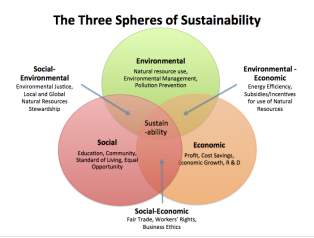 Triple Bottom Line (TBL), is a sustainability related idea introduced by Elkington (1997). This concept come to the forefront when the term “sustainable development” was coined in the Brundtland Report (1987). The Brundtland Report stated sustainable development as “development that meets the needs of the present generations without compromising the ability of the future generations to meet their own needs”[1]. TBL focuses on the notion of environmental sustainability and integrates the social and environmental aspects.
Triple Bottom Line (TBL), is a sustainability related idea introduced by Elkington (1997). This concept come to the forefront when the term “sustainable development” was coined in the Brundtland Report (1987). The Brundtland Report stated sustainable development as “development that meets the needs of the present generations without compromising the ability of the future generations to meet their own needs”[1]. TBL focuses on the notion of environmental sustainability and integrates the social and environmental aspects.
When the developed countries started focusing on the issue of sustainability, in 1997, Stuart Hart noted that ‘Beyond greening lies an enormous challenge – and an enormous opportunity. The challenge is to develop a sustainable global economy: an economy that the planet is capable of supporting indefinitely’ (Hart, 1997). It was then explained by Hart that getting rid of pollution isn’t just the solution to the problem of sustainability and the world would have to look at it from a larger context. Even if zero emission are achieved by 2000, the world would still be stressed in terms of generating resources and in coming times the ability to meet the needs future generations will be destroyed.
The issue at hand is not only bound to economic and environmental realms, it stretches out and connects with ethical, social and political aspects as well. All these aspects will have to be seen from the same prism in order to reach the goal of sustainability. Hence, economic and social bottom lines were added to economic bottom line to get a measure of sustainability.
The economic bottom line: It is the measure of a company’s profits after all the deductions are done. Generally, an organization is said to be improving its economic bottom line when it is increasing its net earnings and reducing costs. Some of the examples include:
The environmental bottom line: It is the measure of natural resources and how would they be sustainably utilized. The concept of natural wealth, thus, becomes important to understand. E.g., one cannot simply make an account of trees cut in a forest and weigh it against a price, but various other functions of trees in a forest would have to be considered also as they contribute in the regulation of water, greenhouse gasses and they also play an important part in maintaining the flora and fauna of the forest. There are 2 forms of natural capital, the first one is called ‘critical natural capital’- which is necessary to sustenance of life and the other is called ‘renewable capital’- which can be replenished or repaired. A company is said to be improving its environmental bottom line when it is has a stable resource base, it is managing its resources and it is continually conserving and maintaining biodiversity and eco system.
The social bottom line: It is the measure of how much an organization is taking care of its employees. For many years, it was believed that sustainability had no link with social, ethical or cultural issues. But, recent studies have shown that, it is the most important factor behind sustainable development. E.g., if in organization the employees trust one another as they all work according to ethical norms, they will be able to work more efficiently as they will create a wide variety of social relationships. A company is said to be improving in its social bottom line when it is treating its employees with equity in terms of health and education, it is promoting gender equality, there’s political accountability and participation of the workers.[2]
There is no unified definition of Triple Bottom Line (TBL) but, generally it can be described as the communication between the corporate entity with its stakeholders that defines the company’s method to manage its environmental, social and economic aspects of its workings. [3]
TBL is a reporting framework which incorporates environmental, social and economic aspects while accounting an organizations performance. These three aspects are also referred to as people, planet and profits where the “people” bottom line is referred to as the measure of how an organization has treated its employees with due care, the “planet” bottom line is referred to as how environmentally responsible the firm has been in its operations and the “profit” bottom line is referred to as how much a the profit and loss accountability. [4]
According to Andrew Savitz TBL “Captures the essence of sustainability by measuring the impact of an organization’s activities on the world … including both its profitability and shareholder values and its social, human and environmental capital”. In short, all these aspects should be viewed in totality in order to ascertain their impacts in a larger context.
There’s no concrete agreement as to how many aspect should be looked into in terms of defining sustainability, some other aspects include community improvement, environment, entrepreneurship and education (Sher & Sher, 1994). But, there’s a consensus that all these aspects are measured in terms of their influences on the society currently and in the days to come.
TBL has made organizational reporting more transparent as the companies have to report on both positive and negative aspects simultaneously in terms of how the company is effecting sustainability. This type of thorough reporting creates better communication with all the stakeholders. There are frequent re-evaluation so that the targets set are met. Moreover, showing TBL reports creates trust between the company and the stakeholders and improves global influence (Ho & Taylor, 2007). [5]
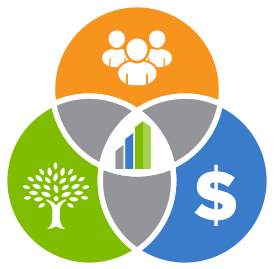
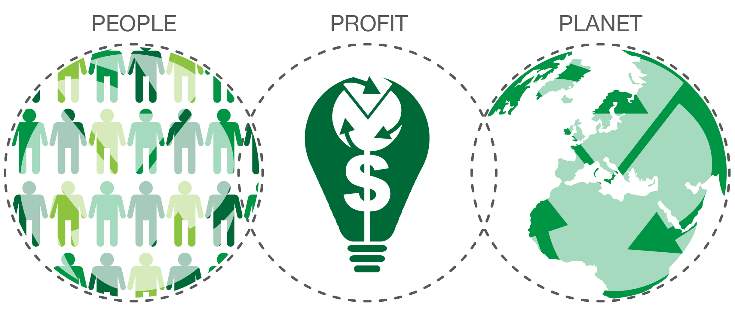

Figure 2 illustrations of TBL, Inspired by Elkington, 1994
The above illustrations show different meanings of triple bottom line but there is a commonality in all these images as all of these illustrations focus on the ‘shared part’. The hard lines between these aspects become blurred and greater emphasis is given to how these aspects interact with each other. TBL can also be referred as a transitional practice where organizations are moving forward from their old methods to new methods and different aspects represent different corporate ambitions. The table below shows the paradigm shifts.
Table 1 The Seven Transitional areas (inspired by Elkington, 2004, 3)

According to Elkington (2004), TBL would start a ‘cultural revolution’ and this revolution will be led by different businesses. Also, external factors such as rapid globalization, deregulation and societal pressures would force these businesses to be open and flexible. These changing aspects are defined below.
Markets: As the competition increases, there is always a growing need to introduce something new which stands out in the market. This creates opportunities to experiment and create newer and better product.
Values: As TBL reporting has created more awareness of the problems regarding market conditions hence, values have changed. E.g., consumers tend to trust organizations which are involved with the community.
Communication: Increased transparency and rapid advancements have led to the need for the corporations to communicate more. E.g., the oil leak by BP was heavily criticized over their corporate misconduct.
Partnership: There is a focus on increased cooperation amongst all the stakeholders. Corporations have identified the fact that increased cooperation and access to external resources would lead to win-win situations more often than not.
Life Cycle Technology: Reconsidering products in terms of their value to the consumers has led to the thought of life cycle assessment which, in return, provides viable eco-friendly results. E.g., Xerox (An American Company) has start aiming at producing waste-free products with better life cycles.
Time: The notion of ‘Time is money’ is very well realized by the organizations and they are quick in reacting to changes. There are systems put in place for reporting at different intervals e.g. “just in time” and “LEAN” production systems.
Corporate Governance: The CEO’s and board members have a shared responsibility to tackle strategic issues; they have to act within the boundaries of Triple Bottom Line. [6]
Modern day business have to take into account a broad spectrum of objectives which are beyond the scope of just making profits. [7] These objectives include:
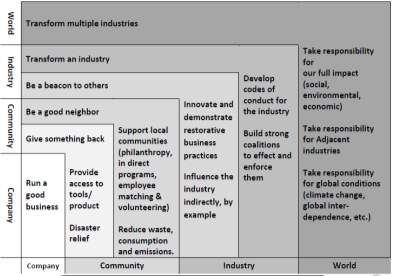 These objectives create a boundary of accountability for which these businesses will be held accountable. Thus, organizations will have to act reasonably and with due diligence. Corporate responsibility (CR) means that these organizations will have to involve all the stakeholders and create parity in the interest of the stake holders. These interests may sometimes overlap, hence it becomes a very delicate management job. Some of these interests are given in the figure 3.
These objectives create a boundary of accountability for which these businesses will be held accountable. Thus, organizations will have to act reasonably and with due diligence. Corporate responsibility (CR) means that these organizations will have to involve all the stakeholders and create parity in the interest of the stake holders. These interests may sometimes overlap, hence it becomes a very delicate management job. Some of these interests are given in the figure 3.
Figure 3 Corporate Responsibility Landscape (McElhaney, 2008, 230)
When describing the relationship between Triple Bottom Line (TBL) and Sustainable Development, it is imperative to understand the meaning of sustainable development first. According to Brundtland Report (WCED, 1987), it is defined as “Development that meets the needs of the present without compromising the ability of future generations to meet their own needs”. Sustainable development connects the carrying capacity of the world with economic, social and environmental realities. “Thus the goals of economic and social development must be defined in terms of sustainability in all countries developed or developing, market-oriented or centrally planned” (World Commission on Environment and Development, 1987). It was further elaborated by Elkington that businesses should not only focus the bottom line of profit, but they will have to include two more bottom lines of environmental stewardship and social progress to achieve true sustainability.
According to Australian Commonwealth, State and Territory Governments Sustainable Development is defined as ‘Development that improves the total quality of life, both now and in the future, in a way that maintains the ecological processes on which life depends. ‘
Australian Building Codes Board define it as ‘Development that effectively balances long and short term economic, environmental and social considerations to meet the needs of the present without compromising the ability of future generations to meet their own needs.’
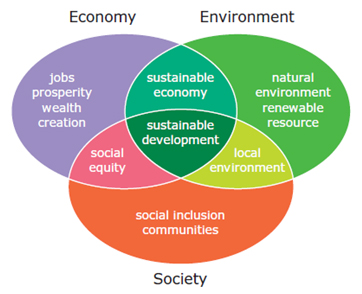
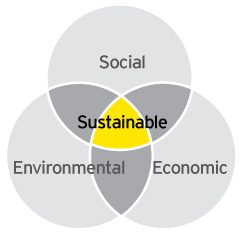
Figure 4 Sustainable Development and TBL (Both Address the Same Aspect)
Triple Bottom Line recognizes the three aspects will have equal impacts in terms of allowing the generations to meet there need and protecting the needs of future generations. Hence, a conspicuous relationship between the two can be identified. According to Payne and Raiborn, 2001 without SD “neither business nor the societies in which they exist will have a long term future”. There have been various definitions of sustainable development proposed like those by Fergus and Rowney, 2005, MacDonald, 2005 and Baumgartner, 2004 etc., but none has gone outside the scope of Triple Bottom Line. Hence, it can be clearly said that there is a strong relationship between the two as sustainable development is a model of triple bottom line.
According to Wang (2015), there are various key themes that sustainable development addresses, these key themes are discussed below as sustainable development:
According to Wang (2015), there are a few key questions which sustainable development will need to answer. These questions are discussed below:
Sustainable development, at its core, derives its concept from balancing the use of resources and managing them well. Growing population and resource mismanagement are hindrances to global development but sustainable development answers these issues by balancing resource usage so that development continues.
Proper management of resources by using principles of sustainability would mean that we will have enough resources to go on in the foreseeable future.
Reduction in forest areas has contributed a lot in global warming and climate change, but reducing deforestation and relying on reusable materials more will lessen the impacts and move us towards sustainable development.
Air pollution, Acid rain, indoor air pollution, water pollution, waste etc., are going to have severe impacts on all the species in the world. We have been witnessing extinction of many species and this trend could reach out to human beings as well. Sustainable development offers a way out by minimizing the pollutants and keeping the environment clean.
We have spread very harmful greenhouse gasses into the atmosphere, polluted our environment and adversely impacted the natural cycles. Global warming and climate change are amongst the various issues that we have created for the future generations. Looking forward, we will have to focus on sustainable development so that our future generations don’t get burdened to meet their needs.
Industries and businesses are the main drivers of sustainable development, hence it is important that the principles of TBL are incorporated in the working procedures of these businesses.
According to Doyle, (1991, p4) ‘I think each of us here can see that however sustainable development is ultimately defined, industry will have the primary role in making it work. We are the experts at development. We do the production for society. It is critical that we assume leadership in this area.’ The importance of industries in sustainable development is emphasized here and it is also believed that that industries will take the leadership role in development. Looking at this scenario the significance of TBL is further strengthened because TBL will define the workings of the businesses and these businesses will further define sustainable development in the world.
Some of the generic characteristics of TBL as defined by Adams (et al., 2004) are defined below.
Accountability – It means that organizations and business will have to be accountable to all the stakeholder in terms of the targets set for economic, social and environmental sustainability. There has been a growing significance of stakeholders and focus on accountability.
Transparency – It means that every organization need to be transparent in the way they conduct their businesses. All the data regarding the three aspects of TBL should be made available to all the stakeholders. This not only solidifies accountability, but also it creates a sense of trust between the organization and the stakeholders. If there are any uncertainties or assumptions in the data, these should also be conveyed to the concerned people.
Measurability – Elkington (1998, p.72) says that the key to managing organization progress towards sustainability is measurement. “What you can’t measure, you are likely to find hard to manage”.[8] Hence, TBL emphasizes on the concept of measurability where social, environmental and economic sustainability factors are measured.
Benchmarking – There are certain standards set by the organizations, these standards are then considered to be the benchmarks which have to be achieved and the performance of the three aspects is weighed against these benchmarks.
Integrated Planning and Management – TBL goals have to be echoed in the planning and management tiers as well. Hence, these goals are defined at the policy level and people are educated to achieve those goals. There’s a strong commitment in understanding stakeholder views and various strategies are formulated to keep everyone a part of the TBL process.
Clarity – Organizations emphasize on the clarity of communication and information availability in order to achieve efficient results.
“The creation and responsible management of a healthy built environment based on resource efficient and ecological principles” (Kibert, 1994, cited in Wang 2015).
“A way of building which aims at reducing negative health and environmental impacts caused by the HES6176 – Environmental Sustainability in Construction © 2011 health and environmental impacts caused by the construction process or by buildings or by the built-up environment” (The Netherlands: CIB, 1999, cited in Wang 2015).
“In its own processes and products during their service life, aims at minimizing the use of energy and emissions that are harmful for environment and health, and produces relevant information to customers for their decision making” (Finland: CIB, 1999, cited in Wang 2015)
“Sustainable construction means that the principles of s stainable development are applied to the of sustainable development are applied to the comprehensive construction cycle from the extraction and beneficiation of raw materials, through the planning, design and construction of buildings and infrastructure, until their final deconstruction and management of the resultant waste. It is a holistic process aiming to restore and maintain harmony between the natural and built environments, while creating settlements that affirm human dignity and encourage economic equity’ (du Plessis, 2002, cited in Wang 2015).
Economic sustainability – efficient use and management of resources which include labor, energy, material and water, hence increasing profits.
Environmental sustainability – reducing emissions and waste wherever possible to protect the environment and efficient use of natural resources.
Social sustainability – taking care of the need of all the stakeholders from start to finish of a project. These people include workers, communities and the supply chain people.
In terms of environment, 40% of all materials and energy are used in construction, 40% of all greenhouse gasses are emitted due to construction and 40% of all the global waste is generated due to construction. In terms of society, 90% of all people’s lives are spent around buildings, quality of life and working conditions of people directly depends on the built environment. In terms of economy, construction takes a huge chunk of global economy and it’s a developing business worldwide.[9] (Source UNEP, 2007) Looking at these figures, it is important that all these aspects are handled in a sustainable manner, so the significance of TBL is realized.
As the global construction industry is growing, the demand for sustainable methods in construction is also growing and the designers and contractors are responding to this fact by incorporating sustainable methods in construction in order to compete in the market. TBL is being practiced by almost all the big construction companies in order to measure the environmental impacts that construction activities have.
TBL has expanded the practices of construction sector by employing social and economic indicators. Organizations have been able to make quantitative and qualitative assessment of their performances and it has yielded very good results in terms of sustainability as well. As there is a big chunk of natural resources spent on construction industry, there has been more focus on managing this sector according to the principles of TBL. Organizations have started to emphasize more on the environmental and social indicators and there has been stress on serving the customer and the stake holders.
As we have taken a lot from the natural resources of the world, it is imperative that we give something back to it as well, this is the sort of awareness that TBL has created in the organizations. In terms of financial results, the profits may be lesser when seen in isolation, but when we include the social and environmental aspects and gauge the sustainability results, they are very optimistic. So, it can be easily said that TBL has changed the landscape of construction industry in terms of its practice and the application of TBL in a sector which consumes a great proportion of natural resources will allow us to develop in a more sustainable manner.
Let us have a look at TBL approach to sustainable construction.
Environmental Aspect – TBL approach to construction is based on resource-efficiency and it includes better management of materials, energy, water and waste. Passive design methods are used so that building consume less energy, it is emphasized that reused materials are used, during construction period it is taken care that lesser water is consumed and wastage is minimized. There are various green rating methods used to see how environmental friendly a building is e.g., in Australia, a Green Star rating system is used and in the US, LEED rating system is used.
Social Aspect – Emphasis is given to the users of the buildings and factors like safety, access and security are considered. Sustainable building design also incorporates the needs of community and makes sure that the building interacts and contributes at a community level instead of working just in an isolated manner.
Economic Aspect – It is made sure that cost efficient construction methods are applied. There are strategies devised to make sure that construction time is minimized. Also, it is made sure that the materials used are cost efficient and durable. Local materials, workforce and suppliers are considered first in order to cut costs, this also helps in reducing time and logistic costs. Cost cutting is also considered at the design level, designers are urged to use cost efficient materials.
All in all, TBL provides a way forward in term of sustainable construction by considering not only the environmental dimension but also the economic and social dimensions.
Company Name: ABC Construction
Establishment Date: 22-12-2007
Area of Expertise: Building Design, Construction, Project Management.
Main Location: Australia
Sub-locations: Pakistan, China, India.
I am Nayab Ahmed, I am the head of Sustainability in this company. We are an international company with head office in Australia and sublets in Pakistan, India and China. The most important goal of our company is to satisfy the clients while keeping sustainability in mind. In order to achieve this goal we are committed to use TBL reporting based on Global Reporting Initiative (GRI).
Section 1
Statement from the CEO of ABC Construction:
We at ABC construction believe that true development is the one which incorporates environmental protection, social development and economic growth. So, we have combined sustainability in our culture and our skills and we seek to achieve these targets by:
We will take into account the interests of our stakeholder and try to achieve our goals according to the GRI G4 standards.
Our main goal is to tackle the challenge of sustainability across social, environmental and economic aspect.
Section 2
The most important opportunities that have risen from sustainability trends are that stakeholders have now realized that sustainability is the way to go in the future. Hence, our Company will try to meet those demands of our clients.
We have identified the key areas that we need to work on and they are reviewed on an annual basis by the Sustainability committee. We will continue to develop on our key area and tackle the risks accordingly.
Table 2 Summary of Key Areas, Goals, Risks
| Key Areas | Long-term Objective | Risks |
| Environmental Impact | Minimize the impact on climate. | Major environmental incident. |
| Quality Assurance | Aspire to provide better services in the times to come. |
You have to be 100% sure of the quality of your product to give a money-back guarantee. This describes us perfectly. Make sure that this guarantee is totally transparent.
Read moreEach paper is composed from scratch, according to your instructions. It is then checked by our plagiarism-detection software. There is no gap where plagiarism could squeeze in.
Read moreThanks to our free revisions, there is no way for you to be unsatisfied. We will work on your paper until you are completely happy with the result.
Read moreYour email is safe, as we store it according to international data protection rules. Your bank details are secure, as we use only reliable payment systems.
Read moreBy sending us your money, you buy the service we provide. Check out our terms and conditions if you prefer business talks to be laid out in official language.
Read more